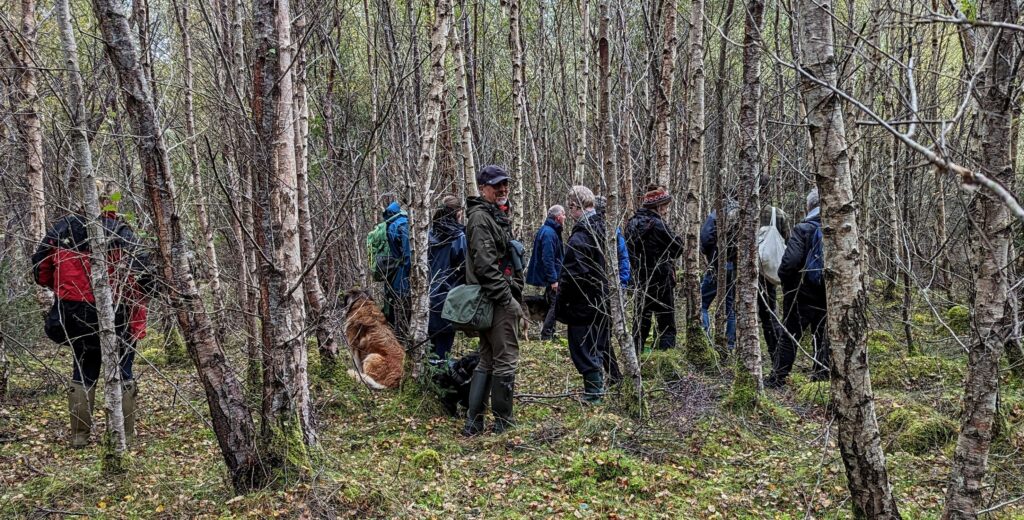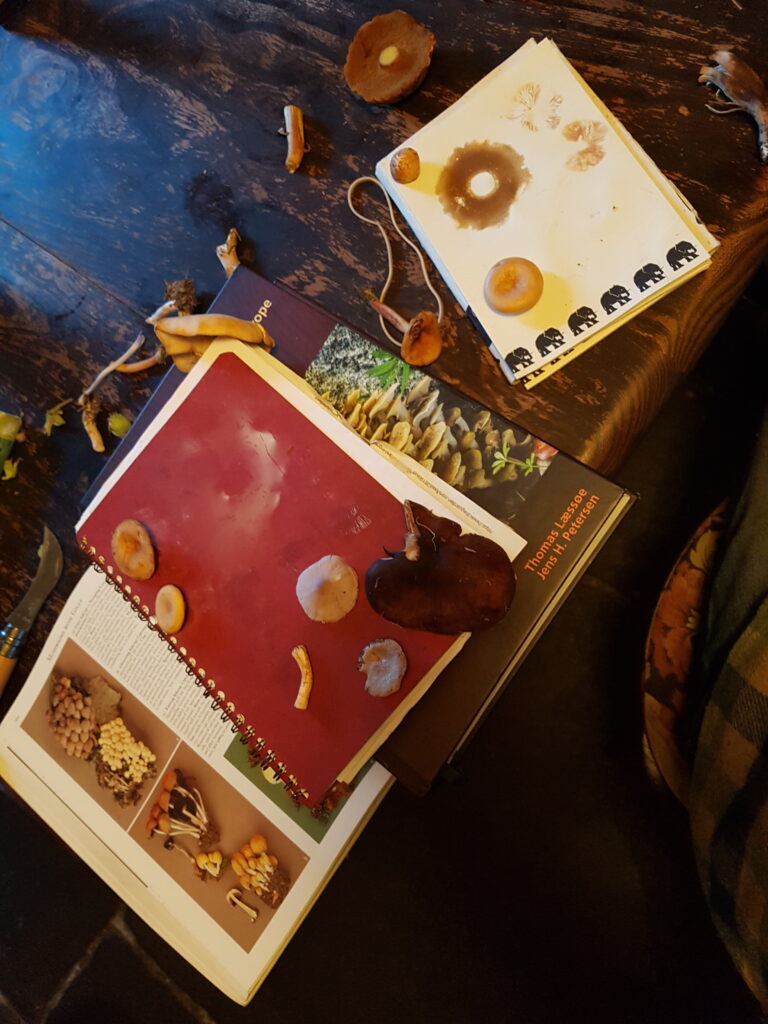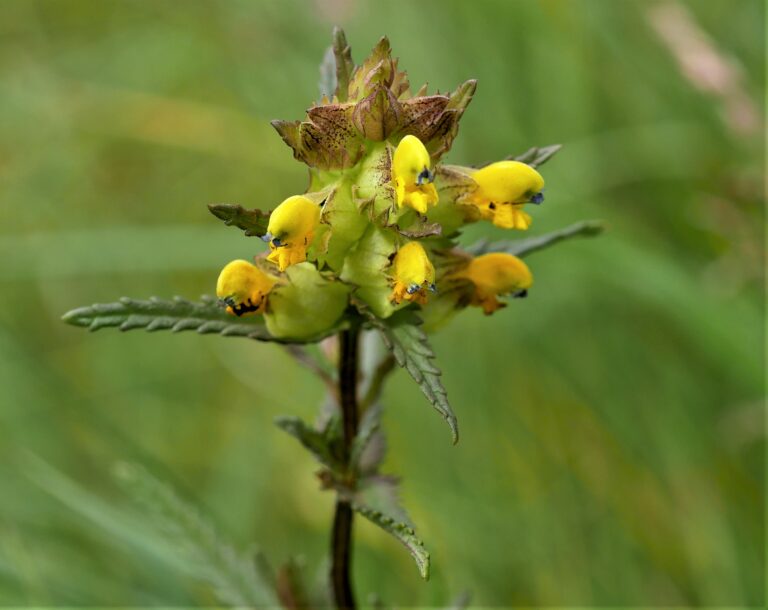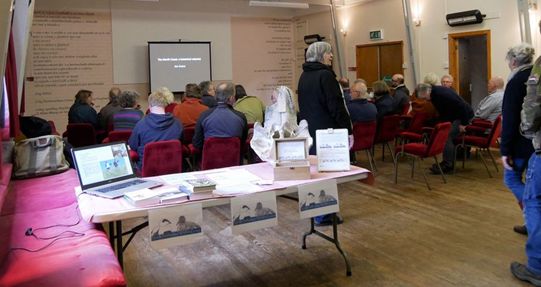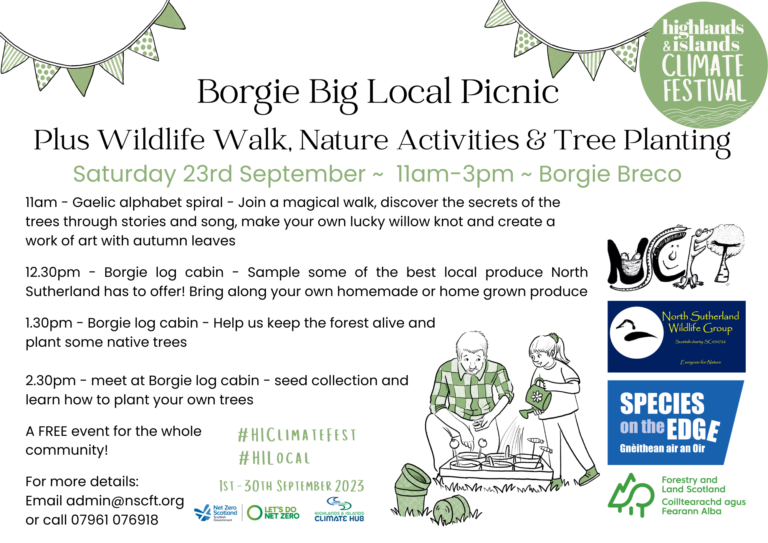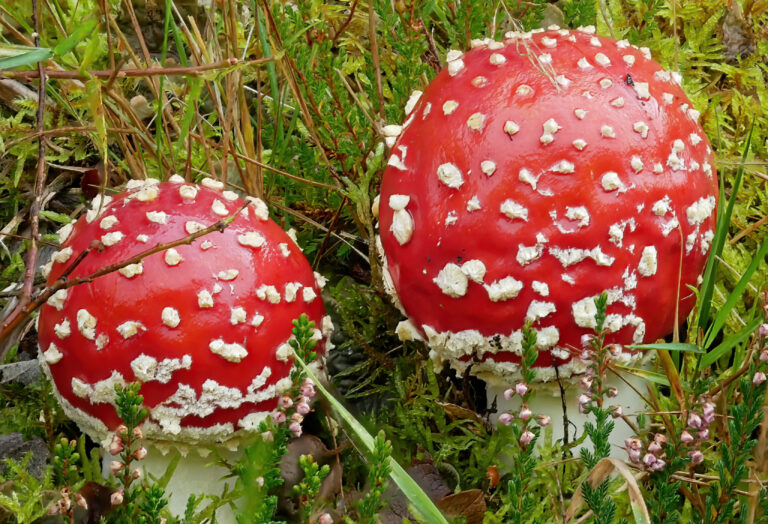North Sutherland Wildlife Group Fungal Foray – Borgie woods – October 8th 2022
by Sarah Bird
It was so good to meet up at the North Sutherland Wildlife Group ‘Pop-Up’ event looking at fungi in Borgie woods. We were surprisingly lucky with the weather and had a good attendance (including a strong canine presence!) – thanks for coming if you were there.

Aurore Whitworth was our knowledgeable guide, and she talked us through the basics before we set off into the woods. The purpose of the event was to help us to identify and record fungi, it was not about foraging for edible fungi. We were reminded that some fungi are poisonous, but that touching is OK. (It is good practise to wash hands after handling fungi, of course).
We learned that the mushroom is only a small part of a bigger fungal organism, that is made up of a branching mat of threads called the mycelium spreading through the soil, wood or leaves beneath the mushroom part. The mushroom is a bit like the flower of the fungus, used for making and releasing spores, that are like seeds. The mycelium can spread over a wide area around the mushroom, absorbing food for the fungus, it often connects with plants too. Indeed, the largest known organism on Earth might be a fungus from the Armillaria family, which spreads over almost 10 square km in the USA! The plants nearby, and habitat are very important for fungal identification. We looked at the area where we were going to search and noted birch and willow trees, gorse, some old rotten conifer stumps, and heathland plants including heather, bracken and bilberry indicating peaty, acid soil.
Aurore explained that we should use our senses when examining fungi – look, touch, smell and even tasting a tiny piece can help distinguish some species. Aurore demonstrated tasting a fragment of the gills of a mushroom and spitting it out afterwards! It is useful to look at how a mushroom grows from the ground, as this often gives clues to help with identification. It is best to carefully pull up the whole mushroom – rather than picking by cutting or snapping the stem – so you can see the base of the stem and how it connects to the fungus underground. Some mushrooms, such as Amanita sp., first appear above the ground in a membrane called a volva that looks a bit like a white egg before the mushroom cap breaks through it. The presence of a volva, or the remains of one, is important for identification. Another feature we looked at was the ring – a frill around the stem of some mushrooms, where the cap has been attached before it opened out. This is obvious in edible mushrooms from the supermarket – in ‘button’ mushrooms the cap is still attached to the stem by the ring.
Other tips from Aurore :
- Look at specimens of differing ages as features may change as the mushroom ages. We saw an old example of Fly Agaric which was pale orange with no white spots; Aurore advised that the rain had washed off the colour and spots!
- Making a spore print helps to see the colour of spores. This is done (at home) by cutting the cap off a mushroom and placing it gills-down on a piece of paper overnight so the spores fall onto the paper. Aurore recommended we use pieces of white and brown paper, as white spores don’t show on white paper. Many guide books show pictures of spore prints or mention the colour. Spore prints can be very beautiful too.
- Watch out for colour changes where damage has occurred. We saw some boletes that had been eaten by slugs and the stem was stained blue! I think it is possible to bruise the stem and see this happen too.

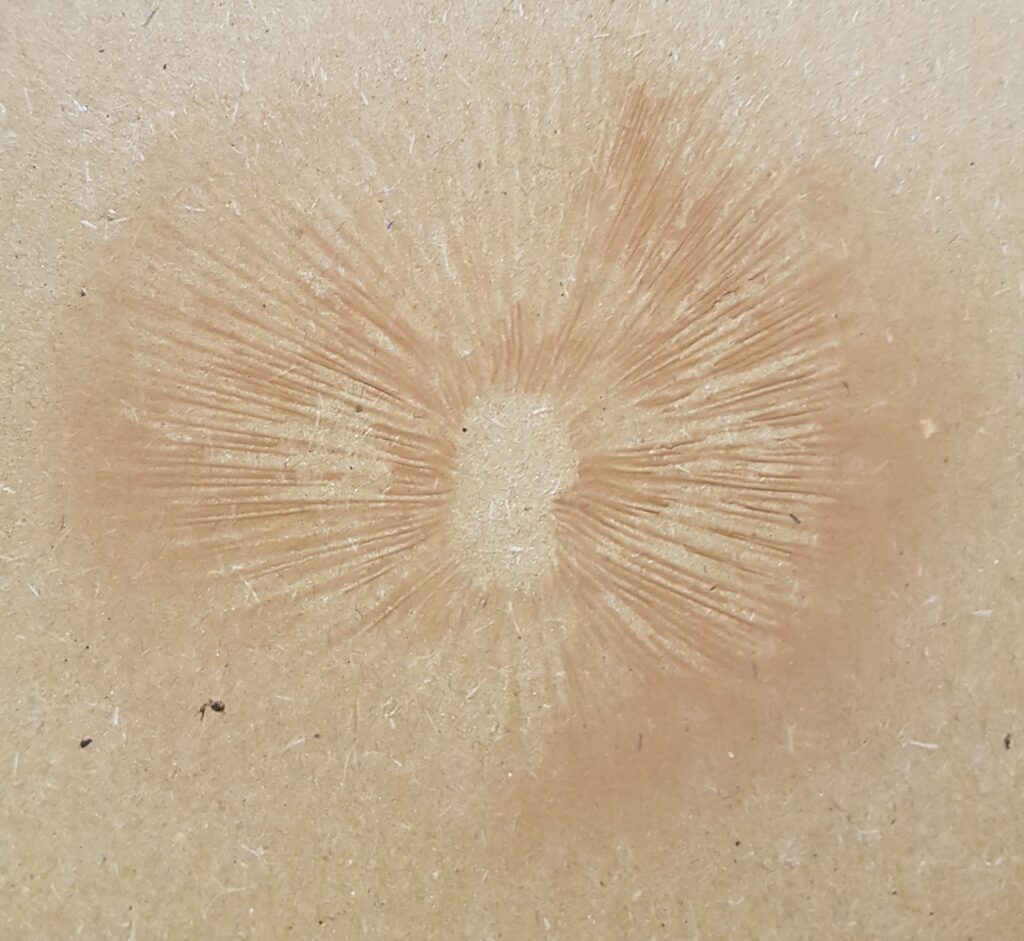

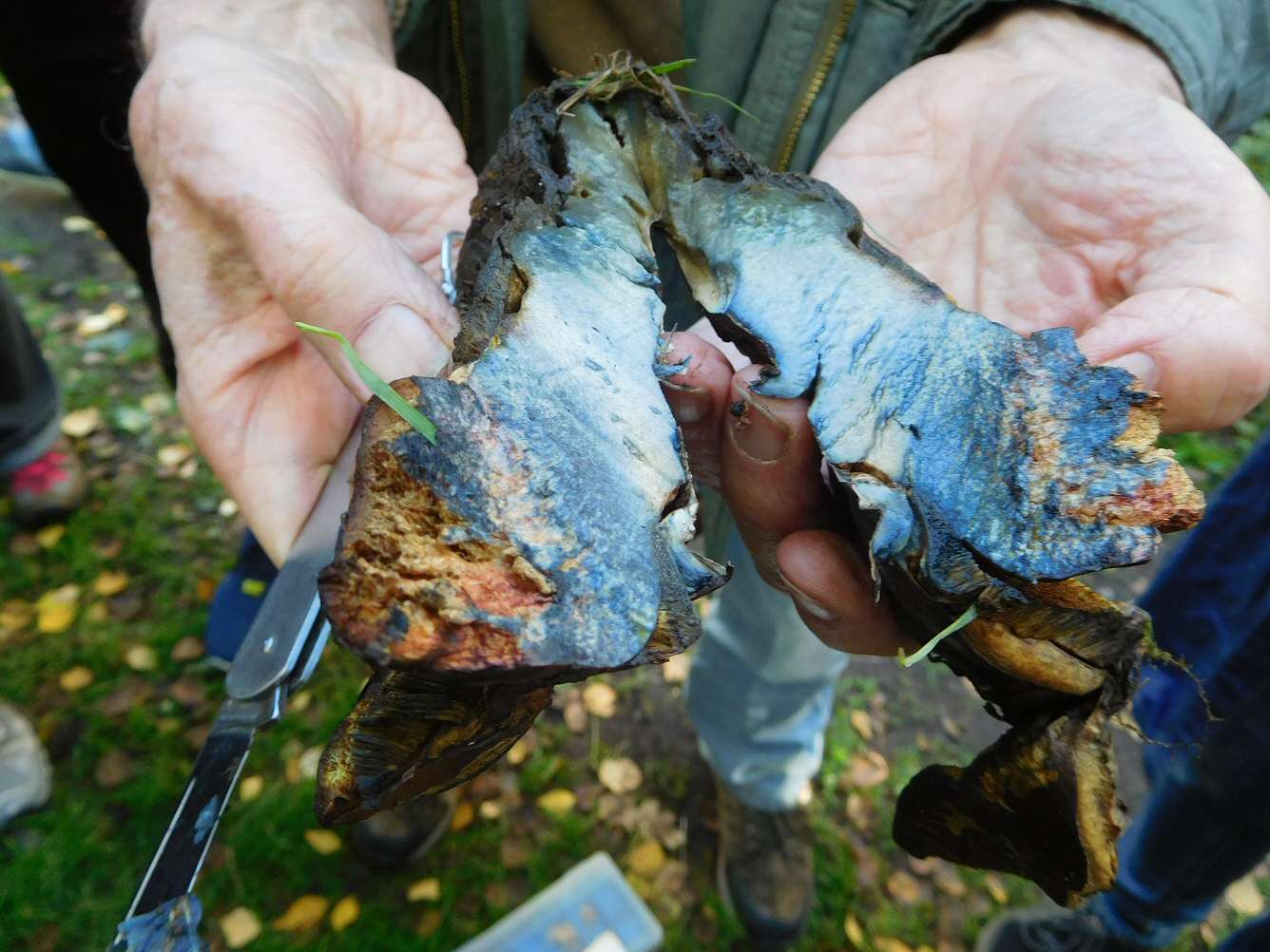
(Photo Credit Ian Alexander, Wikimedia Commons)

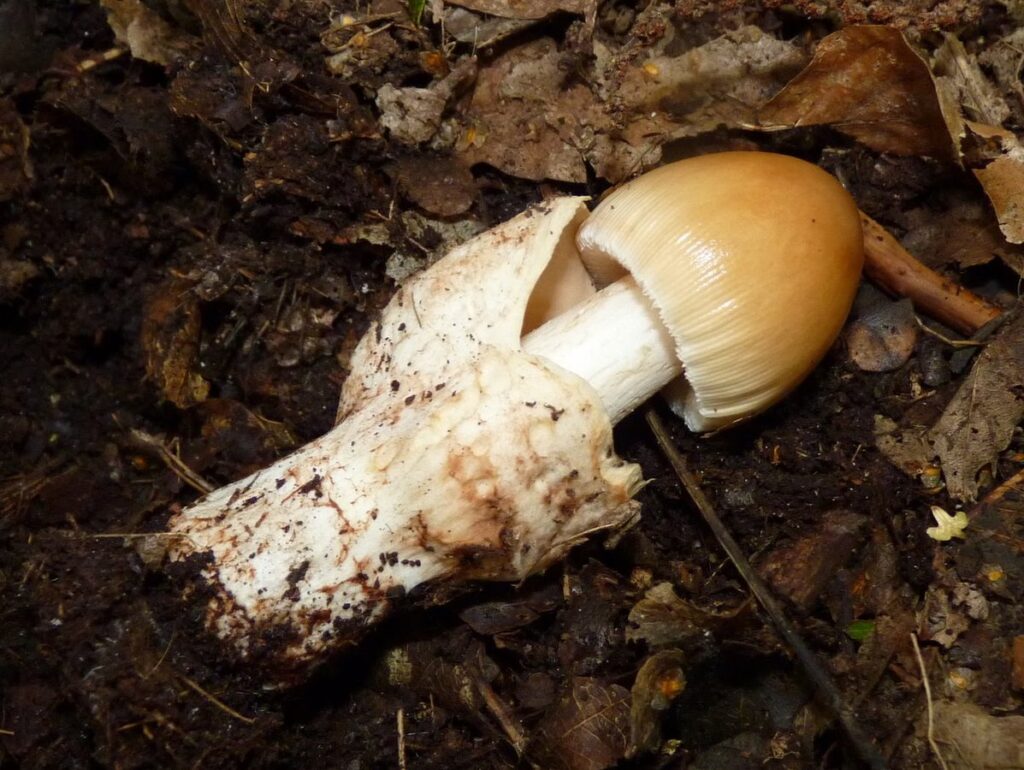
(Photo Credit Hildesvini, Wikimedia Commons)
- We saw some milkcaps – called this because the gills bleed a milky liquid when damaged. Just breaking a few gills was enough to show this. Apparently, the ‘milk’ can change colour when its dry – another thing to look out for.
- How does the mushroom feel – slimy? rubbery? smooth?, scaly? Does it break easily, or is it quite tough?
- Look in different places – around trees, on dead wood on the ground, in moss, on standing dead wood, along the path. There could be different fungi will be in all these places.
- Use more than one identification guide book to check pictures and descriptions if you can.
Into the woods..
So, with all that in mind we eagerly ventured into the woods, and the world of fungi was revealed.
I think everyone found that the longer we searched the more we saw. You certainly ‘get your eye in’ for mushrooms – the woodland floor was absolutely packed with fungi, many of which were perfectly camouflaged in the fallen leaves and moss. There were fungi in dead trees too, and some that weren’t mushroom shaped at all..

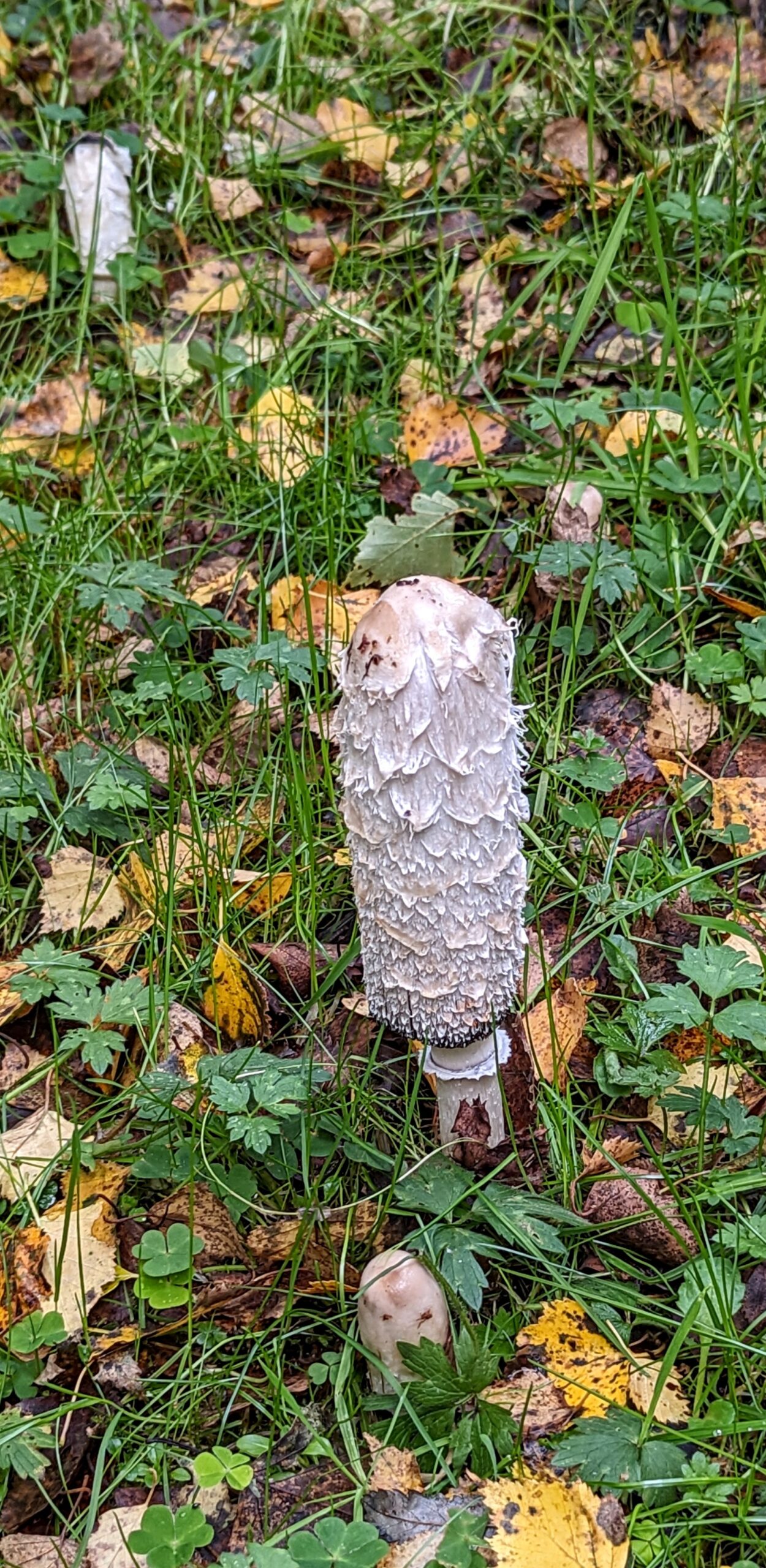

After an hour or so in the woods we came back to the track and spread out some of our fungal finds on the picnic table – what a show! We checked out identification with guide books, and it was helpful to see how the different features are described.
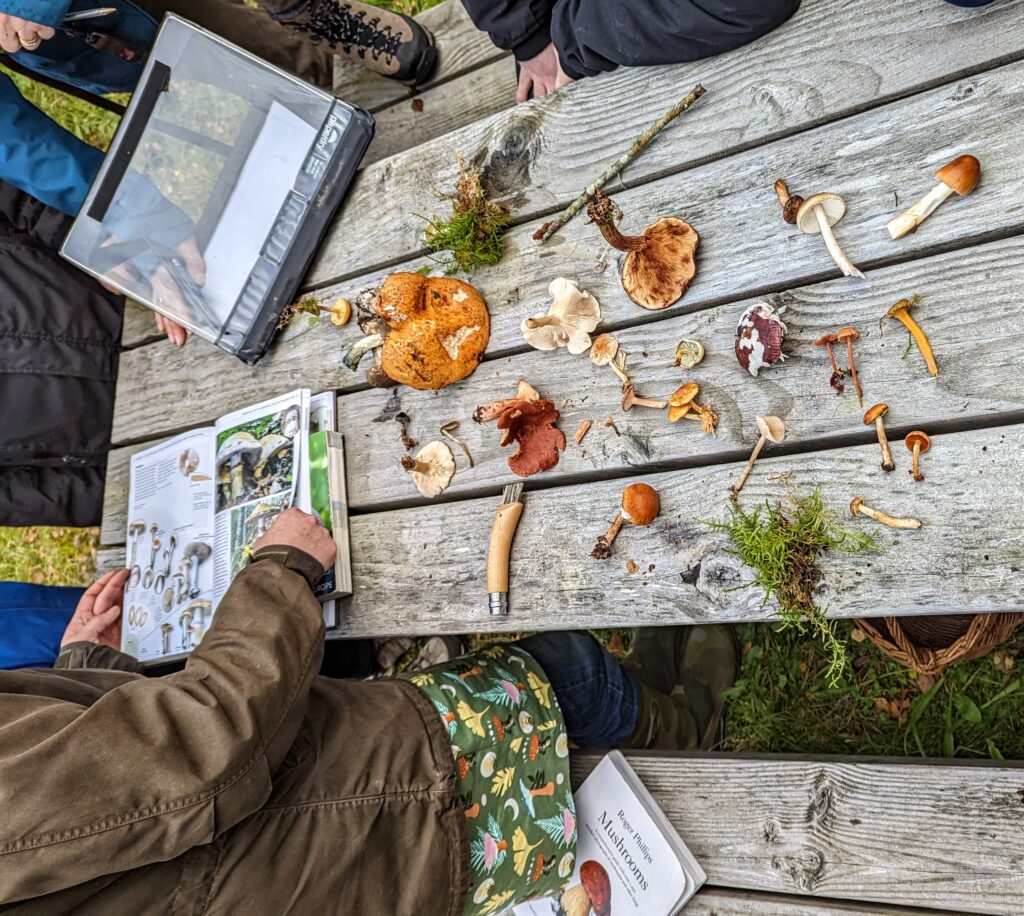
Here is a list of what we found:
| Common name | Scientific name | Notes |
| Tawny Grisette | Amanita fulva | Brown cap |
| Fly Agaric | Amanita muscaria | Specimens with classic red colour and white spots, and some faded to orange and no spots |
| Olive amanita | Amanita submembranacea | Grisette-like amanita, with remains of volva at base |
| Yellow Stagshorn | Calocera viscosa | a coral-like fungus growing on deadwood |
| Shaggy inkcap | Coprinus comatus | Young specimens like tampons, opening to a narrow cap, which dissolves into black ink. |
| Webcap sp. | Cortinarius sp. likely Telamonia subgenus | web-like threads under the cap |
| Birch polyphore | Fomitopsis betulina | on standing dead birch tree |
| Poisonpie sp. | Hebeloma sp. | |
| Sulphur tuft | Hypholoma fasciculare | Colours of gills changed in older specimens |
| Coconut milkcap | Lactarius glyciosmus | Gills bled white milk, feint smell of coconut |
| Rufous milkcap | Lactarius rufus | Gills bled white milk, cap red-brown, not much smell |
| Bolete sp. | Leccinum cyaneobasileucum | Stem base stained blue, spores white, cap brownish |
| Orange birch bolete | Leccinum versipelle | Big fungi, pores not gills |
| Jellybaby | Leotia lubrica | Felt rubbery and slimy |
| Common Puffball | Lycoperdon perlatum | We saw various sizes. Amazing warty pattern on the top surface |
| Stump puffball | Lycoperdon pyriforme | Small puffballs clustered on wood |
| Yellow leg bonnet | Mycena epitpterygia | Stem yellowish |
| Brown Roll rim | Paxillus involutus | Rim of the cap rolled |
| Dyers mazegill | Phaeolus schweinitzii | Uncertain identification. Bracket on standing dead birch. |
| Angel’s wings | Pleurocybella porrigens | Beautiful pure white fungi on dead stump |
| Clustered Brittlestem | Psathyrella multipedata | Cluster of small yellow mushrooms on deadwood |
| Red brittlegill | Russula emetica | |
| Brittlegill sp. | Rusula sp. | Uncertain identification. Purple cap, gills tasted mild, cap peeled easily |
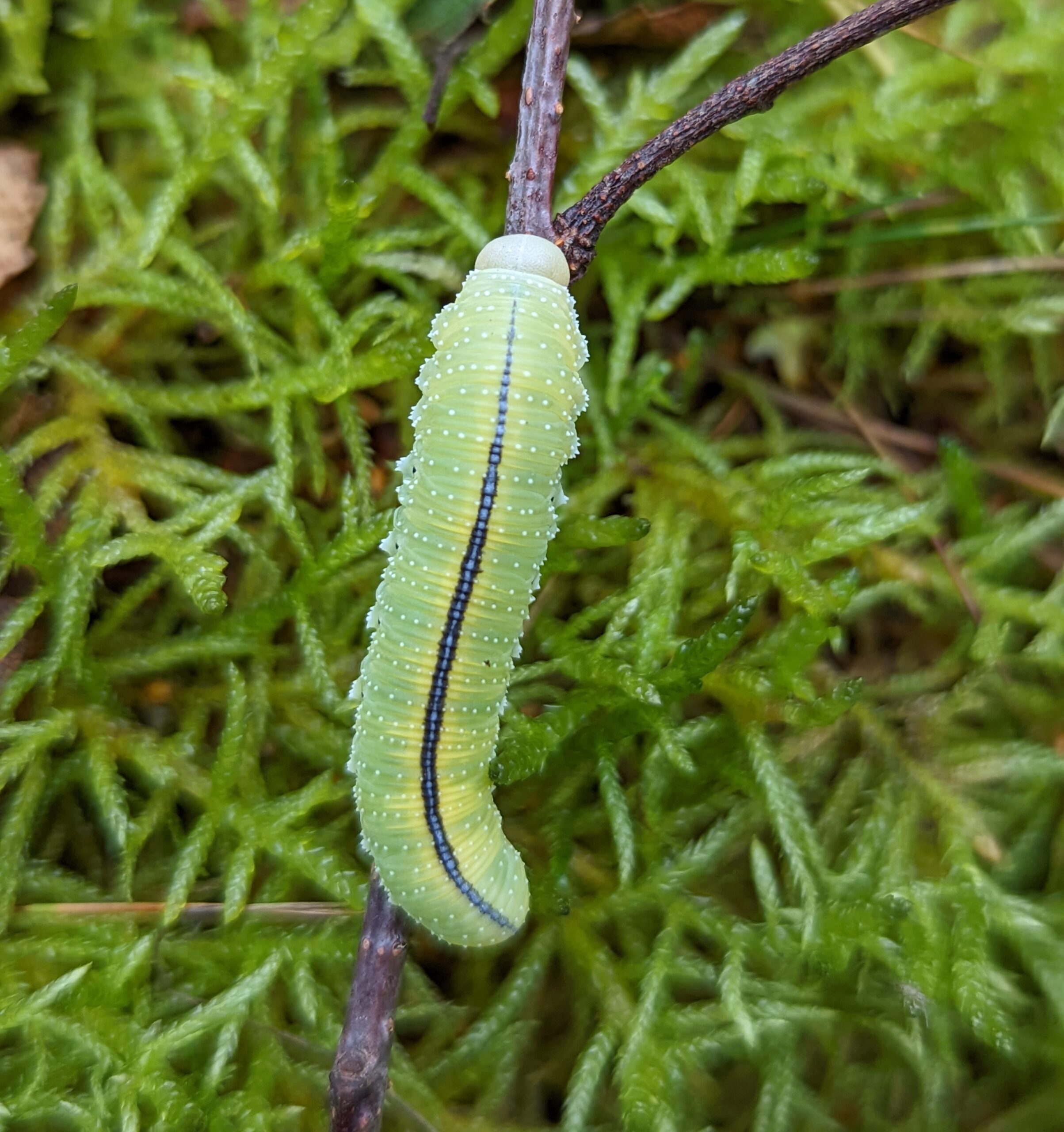
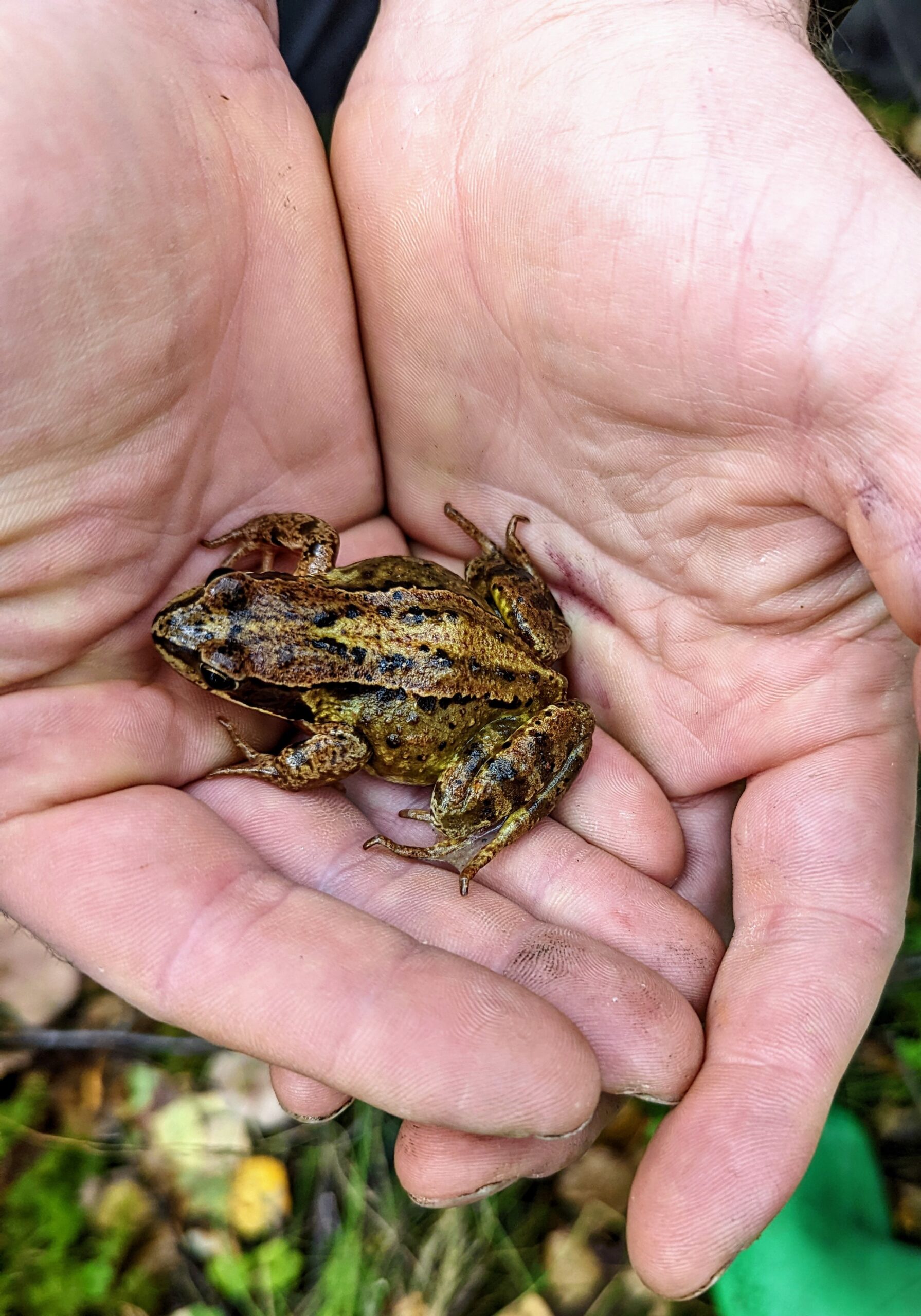
We also came across a lovely common frog and a sawfly larva (to be identified).
After a fascinating afternoon we left all our fungi in the woods so that they could release their spores in their home habitat, and decay back into the forest floor.
As always, we would very much like to hear about what fungi you have found. Post pictures on our Facebook group for Aurore and other experts to look at – but remember to try to show key features, and describe the habitat – it probably needs more than one picture!
Big thank you to Aurore for her enthusiasm and patience with us!
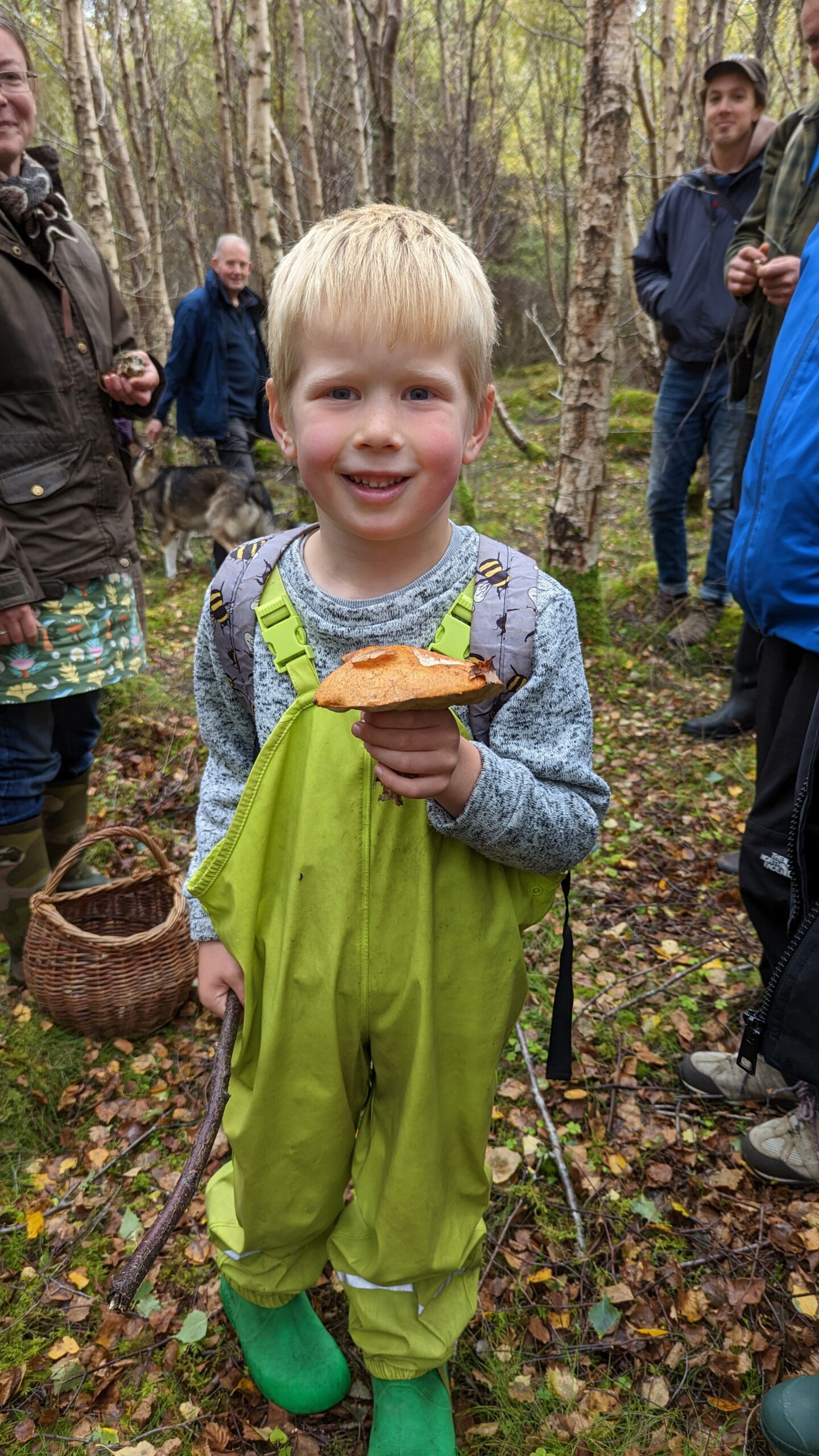
Thank you to Aurore Whitworth and Susan Kirkup for photos.

